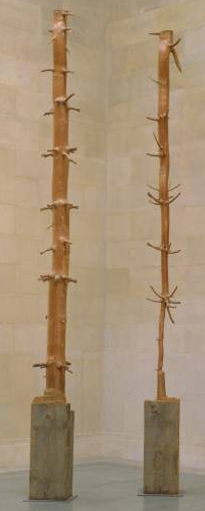Giuseppe Penone at the Arnolfini and Georg Herold at Karsten Schubert Gallery
NOT CONTENT with finding tongues in trees, books in the running brooks and sermons in stones, Giuseppe Penone - who has, in the past, made a considerable quantity of art out of trees, water and rocks - discovers aesthetic potential in dust samples, human hair, nail-clippings and much else besides. On the evi-dence of his slimline exhibition at the Arnolfini, Penone, an inheritor of late 1960s subversiveness (he gradu-ated from Turin Art School in 1968) is still busily addressing the preoccupations of an era that spawned myr-iad alternatives to the mainstream. What he makes could be described as (take your pick) Earth Art, Land Art, Body Art, Process Art or Conceptual Art.
Instead of flower power, Penone proposes tree power. Five Metre Tree is characteristic, an arranged marriage of perversity and elegance. He has taken a thick wooden plank and, patiently gouging and chipping away, has carved it back into the sapling it once was. It is important to Penone that he arrives at his hard-won, hardwood resurrections (something of a trademark - he is represented by two more planks-restored-to-treeness in the Royal Academy's current survey of 'Italian Art in the Twentieth Century') by, as it were, following nature's instructions. He traces twigs back from the knots in a given plank, carefully peels back the years recorded in the ex-tree's growth rings. The result, rubbed and burnished to a shine, is a neat encapsulation of Penone's attitudes to art - not, essentially, an act of creation, but of retrieval, a literal getting back to nature.
Penone is a leading exponent of arte povera, a loose grouping of Italian artists who forsake traditional materials like marble or oil on canvas for urban refuse or natural ephemera. He...

Timber Merchants
21-02-1989

